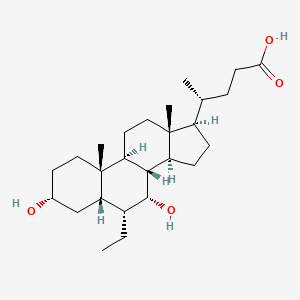





1. 6-ecdca
2. 6-ethyl Chenodeoxycholic Acid
3. 6-ethyl-3,7-dihydroxycholan-24-oic Acid
4. 6-ethylchenodeoxycholic Acid
5. 6alpha-ethyl-3alpha,7alpha-dihydroxy-5beta-cholan-24-oic Acid
6. 6alpha-ethyl-chenodeoxycholic Acid
7. 6ecdca
8. Cholan-24-oic Acid, 6-ethyl-3,7-dihydroxy-, (3alpha,5beta,6alpha,7alpha)-
9. Dsp-1747
10. Dsp1747
11. Int 747
12. Int-747
13. Int747
14. Ocaliva
1. 459789-99-2
2. 6-ecdca
3. Int-747
4. 6-ethylchenodeoxycholic Acid
5. Ocaliva
6. Obetichloic Acid
7. 6alpha-ethyl-chenodeoxycholic Acid
8. Int747
9. Int 747
10. Dsp-1747
11. 6-ethyl-cdca
12. (4r)-4-[(3r,5s,6r,7r,8s,9s,10s,13r,14s,17r)-6-ethyl-3,7-dihydroxy-10,13-dimethyl-2,3,4,5,6,7,8,9,11,12,14,15,16,17-tetradecahydro-1h-cyclopenta[a]phenanthren-17-yl]pentanoic Acid
13. 6-ethyl-chenodeoxycholic Acid
14. 6alpha-ethylchenodeoxycholic Acid
15. 0462z4s4oz
16. 6alpha-ethyl-3alpha,7alpha-dihydroxy-5beta-cholan-24-oic Acid
17. 6ecdca
18. (4r)-4-[(1s,2s,5r,7s,8r,9r,10s,11s,14r,15r)-8-ethyl-5,9-dihydroxy-2,15-dimethyltetracyclo[8.7.0.0^{2,7}.0^{11,15}]heptadecan-14-yl]pentanoic Acid
19. Unii-0462z4s4oz
20. 6-et Cdca
21. Obeticholic Acid [usan]
22. Obeticholic Acid [usan:inn]
23. 1osv
24. Dsp1747
25. Ocaliva (tn)
26. 6-ethyl-3,7-dihydroxycholan-24-oic Acid
27. 6-ecdca; Obeticholic Acid
28. Obeticholic Acid [mi]
29. Schembl715823
30. Obeticholic Acid (int-747)
31. Obeticholic Acid [inn]
32. Obeticholic Acid [jan]
33. Chembl566315
34. Gtpl3435
35. (3alpha,5beta,6alpha,7alpha)-6-ethyl-3,7-dihydroxycholan-24-oic Acid
36. Bdbm21675
37. Chebi:43602
38. Dtxsid20196671
39. Ex-a387
40. 6-alpha-ethylchenodeoxycholic Acid
41. Obeticholic Acid [who-dd]
42. Obeticholic Acid (jan/usan/inn)
43. Amy16595
44. Mfcd16621104
45. Zinc14164617
46. Akos024259126
47. Cholan-24-oic Acid, 6-ethyl-3,7-dihydroxy-, (3alpha,5beta,6alpha,7alpha)-
48. Obeticholic Acid [orange Book]
49. Cs-3813
50. Db05990
51. Gs-6103
52. Ncgc00480885-01
53. Hy-12222
54. D09360
55. P16663
56. A854341
57. Q15708271
58. 3a, 7a -dihydroxy-6a -ethyl-5b-cholan-24-oic Acid
59. 3alpha,7alpha-dihydroxy-6alpha-ethyl-5beta-cholan-24-oic Acid
60. (3alpha,5beta,6alpha,7alpha,8xi)-6-ethyl-3,7-dihydroxycholan-24-oic Acid
61. (3beta,5beta,6alpha,7beta)-6-ethyl-3,7-dihydroxycholan-24-oic Acid
62. (3.alpha.,5.beta.,6.alpha.,7.alpha.)-6-ethyl-3,7-dihydroxycholan-24-oic Acid
63. (r)-4-((3r,5s,6r,7r,8s,9s,10s,13r,14s,17r)-6-ethyl-3,7-dihydroxy-10,13-dimethyl-hexadecahydro-1h-cyclopenta[a]phenanthren-17-yl)pentanoic Acid
64. (r)-4-((3r,7r,8s,9s,10s,13r,14s,17r)-6-ethyl-3,7-dihydroxy-10,13-dimethyl-hexadecahydro-1h-cyclopenta[a]phenanthren-17-yl)pentanoic Acid
65. Cholan-24-oic Acid, 6-ethyl-3,7-dihydroxy-, (3.alpha.,5.beta.,6.alpha.,7.alpha.)-
| Molecular Weight | 420.6 g/mol |
|---|---|
| Molecular Formula | C26H44O4 |
| XLogP3 | 5.7 |
| Hydrogen Bond Donor Count | 3 |
| Hydrogen Bond Acceptor Count | 4 |
| Rotatable Bond Count | 5 |
| Exact Mass | 420.32395988 g/mol |
| Monoisotopic Mass | 420.32395988 g/mol |
| Topological Polar Surface Area | 77.8 Ų |
| Heavy Atom Count | 30 |
| Formal Charge | 0 |
| Complexity | 649 |
| Isotope Atom Count | 0 |
| Defined Atom Stereocenter Count | 11 |
| Undefined Atom Stereocenter Count | 0 |
| Defined Bond Stereocenter Count | 0 |
| Undefined Bond Stereocenter Count | 0 |
| Covalently Bonded Unit Count | 1 |
Obeticholic acid is indicated for the treatment of primary biliary cholangitis in combination with ursodeoxycholic acid (UDCA) in adults with an inadequate response to UDCA. It is also used as a monotherapy in adults with PBC that are unable to tolerate UDCA. Obeticholic acid is currently being considered for FDA approval to treat fibrosis caused by non-alcoholic liver steatohepatitis (NASH), and is likely to be approved for this indication in 2020.
FDA Label
Ocaliva is indicated for the treatment of primary biliary cholangitis (also known as primary biliary cirrhosis) in combination with ursodeoxycholic acid (UDCA) in adults with an inadequate response to UDCA or as monotherapy in adults unable to tolerate UDCA.
Treatment of non-alcoholic steatohepatitis (NASH)
Treatment of biliary atresia, Treatment of primary biliary cirrhosis
The activation of the FXR by obeticholic acid acts to reduce the synthesis of bile acids, inflammation, and the resulting hepatic fibrosis. This may increase the survival of patients with PBC, but to date, an association between obeticholic acid and survival in PBC has not been established.
A05AA04
A05AA04
S76 | LUXPHARMA | Pharmaceuticals Marketed in Luxembourg | Pharmaceuticals marketed in Luxembourg, as published by d'Gesondheetskeess (CNS, la caisse nationale de sante, www.cns.lu), mapped by name to structures using CompTox by R. Singh et al. (in prep.). List downloaded from https://cns.public.lu/en/legislations/textes-coordonnes/liste-med-comm.html. Dataset DOI:10.5281/zenodo.4587355
A - Alimentary tract and metabolism
A05 - Bile and liver therapy
A05A - Bile therapy
A05AA - Bile acids and derivatives
A05AA04 - Obeticholic acid
Absorption
Obeticholic acid is absorbed in the gastrointestinal tract. The Cmax of obeticholic acid occurs at approximately 1.5 hours after an oral dose and ranges from 28.8-53.7 ng/mL at doses of 5-10mg. The median Tmax for both the conjugates of obeticholic acid is about 10 hours. One product monograph reports a Tmax of 4.5h for both 5 and 10mg doses. The AUC ranged from 236.6-568.1 ng/h/mL with 5mg to 10 mg doses.
Route of Elimination
About 87% of an orally administered dose is accounted for in the feces. Less than 3% of the dose can be recovered in the urine.
Volume of Distribution
The volume of distribution of obeticholic acid is 618 L.
Clearance
Clearance information for obeticholic acid is not readily available in the literature.
The metabolism of obeticholic acid occurs in the liver. Obeticholic acid is conjugated with glycine or taurine, followed by secretion into bile. The conjugates are then absorbed in the small intestine and then re-enter the liver via enterohepatic circulation. The intestinal microbiota in the ileum converts conjugated obeticholic acid in a deconjugated form that may be either reabsorbed or eliminated. Glycine conjugates account for 13.8% of the metabolites and taurine conjugates account for 12.3%. Another metabolite, 3-glucuronide, may also be formed, but displays little pharmacological activity.
The biological half-life of obeticholic acid is reported to be 24 hours.
Primary biliary cirrhosis is an autoimmune process by which the bile ducts and liver are damaged progressively, leading to fibrosis and cirrhosis. Bile acids increase the risk of damage and fibrosis to the damaged bile ducts. Obeticholic acid is a potent agonist of the farnesoid X receptor, which serves to regulate the hepatic metabolism of bile and cholesterol. This drug acts by binding to the farnesoid X receptor (FXR), found in the nucleus of liver and intestinal cells, which in turn increases liver bile flow, suppressing its production and decreasing hepatocyte exposure to excess levels of bile with cholestasis. Cholestasis is a process that normally causes inflammation and cirrhosis of the liver.



